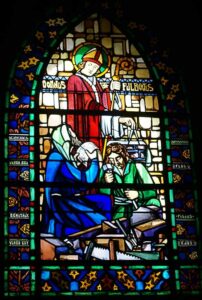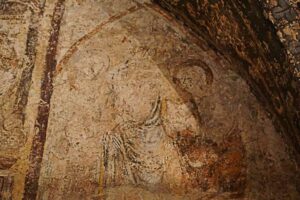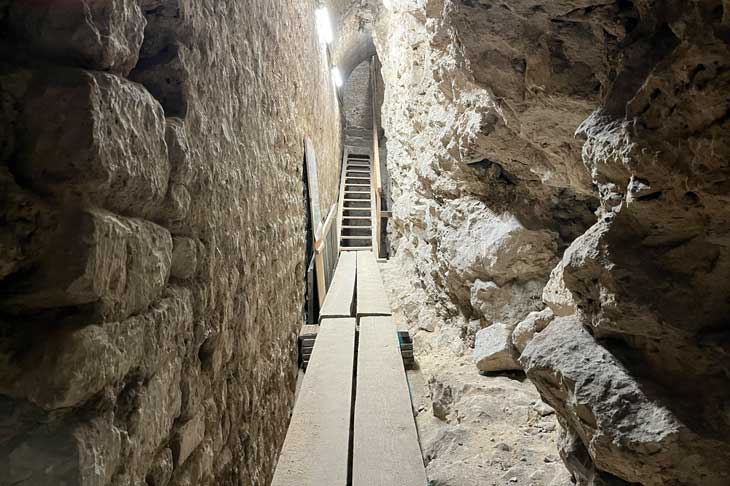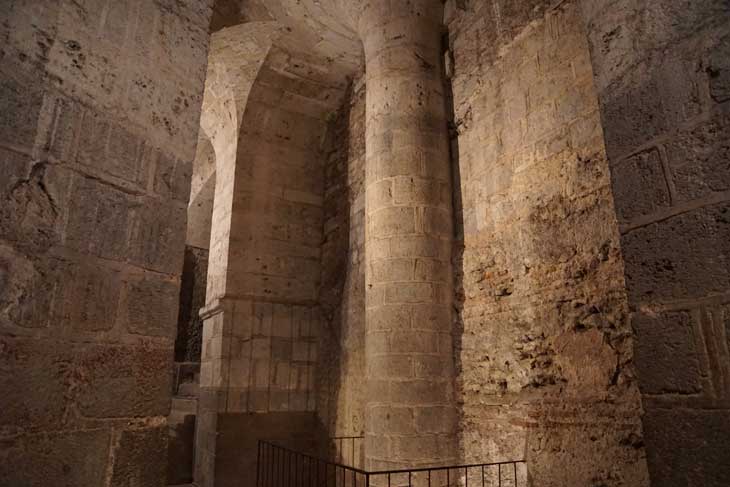
Fulbert the Builder, Stained Glass by Gabriel Loire (1929) © NDC
The year 1024 marks a significant milestone in the history of Chartres and its cathedral. Bishop Fulbert celebrates the completion of his lower church’s construction before the arrival of winter. This structure represents the first stage of his cathedral project.
Indeed, a cathedral derives its name from the bishop’s seat, the cathedra. But since when has Chartres been home to a bishopric?
Chartrian legend traces Christianity in the city back to the first century —making it at least contemporary with Mary, following Christ’s Ascension. One episode of this legend even predates Jesus’ birth, featuring a statue said to depict the Virgin who would bear a child.
In his 1965 book The Three Notre-Dames of Chartres Cathedral, Canon Delaporte states: “We need not determine what, if anything, can be retained from these accounts, whose legendary nature is evident to all.” By “these accounts,” he refers to various authors who, over previous centuries, cited or even expanded upon the belief that, long before the Nativity, our ancestors had prophetically foreseen the future Incarnation of Jesus, the Son of God.

Sending out the disciples © NDC
Similarly, Christianity was to be anchored as closely as possible to Jesus’ presence on Earth. Another legendary episode reinforces this notion: two of Jesus’ disciples —among the seventy-two mentioned by Luke (10:1), Savinian and Potentian— are said to have initiated the Christianization of Chartres (Autricum) and its surrounding region. However, this claim remains unverified. According to the Diocese of Sens, through which these two saints reportedly traveled, their presence is attested not in the first century but rather in the third or fourth century.
At the end of this article, we include an excerpt from The History of a Founding Myth, a chapter from Chartres: The Grace of a Cathedral (pp. 409-418) by Marie-Francine Jourdan.
Although we must remain cautious due to the lack of precise written or oral tradition, evidence suggests that the first bishop appointed to the Diocese of Chartres was Adventinus (or Aventinus) in the late fourth century.
It was only then that Chartres’ first cathedral could have emerged—still far from the grand structures that would rise in later centuries.
While no written records document these early buildings, excavations, research, and analysis of findings provide some insight.

Saint Lubin Crypt, Merovingian Wall © NDC

Saint Lubin crypt, west wall pillar © NDC
In the Saint Lubin Crypt, located beneath the Assumption altar in the cathedral’s choir, a few Merovingian-era construction elements have been identified.
Another clue suggests the presence of a significant church in the eighth century. In 743, Hunald, Duke of Aquitaine, waged war against King Pepin the Short. He besieged and sacked the city of Chartres. Following this destruction, the king made a donation to the Church of Saint Mary. This provides two key indications: first, that a church of considerable importance existed for the king to take an interest in it; and second, that it was dedicated to Mary.
One hundred ten years later, the Vikings would destroy the cathedral.
Going further back in time, the Saint Lubin Crypt reveals additional construction details. The north wall follows a Gallo-Roman design, likely dating from the fourth or fifth century, though its precise dating remains uncertain. While this observation alone does not provide a definitive date, it aligns with another discovery: the base of a well rediscovered in 1901 by René Merlet during excavations. This well’s base is also of Gallo-Roman construction.
Although no architectural or chronological link can be definitively established between these two structures, they strongly suggest an ancient dating for certain elements preceding the successive cathedrals built on this site.
The first church in Chartres seems to date from the fourth century, coinciding with the appointment of its first bishop. In 313, Emperor Constantine issued the Edict of Milan, establishing religious tolerance. Before his death, he was baptized —a milestone that catalyzed Christianity’s expansion throughout the empire.
In the sixth century, Bishop Solemnis is noted for having contributed to the religious instruction of Clovis.
By aligning tangible archaeological findings with sometimes uncertain historical information, it seems clear that Christianity has been interwoven with Chartres’ history since its expansion in the Roman Empire. Cathedrals have risen in succession on the plateau overlooking the Eure, likely dedicated to Mary from the very beginning.
Legends have served to reinforce Chartres’ Christian identity over centuries while also deepening Marian devotion.
Is it not said that Mary “chose Chartres” as her earthly residence? Of course, this remains a legend, but are such legends not expressions of profound faith —or, at the very least, an effort to strengthen it?
Savinien et Potentien : Excerpt from « Chartres, The Grace of a Cathedral » (p. 410)
A legend developed in the eleventh century by Gerbert, a monk from the metropolitan church of Sens, made its way into the twelfth-century Chartrian Breviary and Lectionary. The Passion of Savinian recounts that Savinian, Potentian, and Altin were among Christ’s seventy-two disciples. Peter sent them to preach the Gospel in Gaul. They established a church in Sens.
Altin and Eodald —a newly converted disciple— were dispatched by Savinian to Chartres, where they converted part of the population and consecrated a building dedicated to the Mother of God. Quirinius, the city’s governor, imprisoned them, and the faithful who were martyred were thrown into a well. Quirinius later died. Altin and Eodald, freed, rejoined Savinian in Sens. All of them eventually perished as martyrs.
article proposed by the Chartres Cathedral Reception & Visits Service,
as part of the crypt’s millennium celebrations